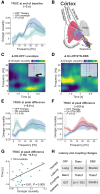Dopamine and deep brain stimulation accelerate the neural dynamics of volitional action in Parkinson's disease
- PMID: 38954651
- PMCID: PMC11449126
- DOI: 10.1093/brain/awae219
Dopamine and deep brain stimulation accelerate the neural dynamics of volitional action in Parkinson's disease
Abstract
The ability to initiate volitional action is fundamental to human behaviour. Loss of dopaminergic neurons in Parkinson's disease is associated with impaired action initiation, also termed akinesia. Both dopamine and subthalamic deep brain stimulation (DBS) can alleviate akinesia, but the underlying mechanisms are unknown. An important question is whether dopamine and DBS facilitate de novo build-up of neural dynamics for motor execution or accelerate existing cortical movement initiation signals through shared modulatory circuit effects. Answering these questions can provide the foundation for new closed-loop neurotherapies with adaptive DBS, but the objectification of neural processing delays prior to performance of volitional action remains a significant challenge. To overcome this challenge, we studied readiness potentials and trained brain signal decoders on invasive neurophysiology signals in 25 DBS patients (12 female) with Parkinson's disease during performance of self-initiated movements. Combined sensorimotor cortex electrocorticography and subthalamic local field potential recordings were performed OFF therapy (n = 22), ON dopaminergic medication (n = 18) and on subthalamic deep brain stimulation (n = 8). This allowed us to compare their therapeutic effects on neural latencies between the earliest cortical representation of movement intention as decoded by linear discriminant analysis classifiers and onset of muscle activation recorded with electromyography. In the hypodopaminergic OFF state, we observed long latencies between motor intention and motor execution for readiness potentials and machine learning classifications. Both, dopamine and DBS significantly shortened these latencies, hinting towards a shared therapeutic mechanism for alleviation of akinesia. To investigate this further, we analysed directional cortico-subthalamic oscillatory communication with multivariate granger causality. Strikingly, we found that both therapies independently shifted cortico-subthalamic oscillatory information flow from antikinetic beta (13-35 Hz) to prokinetic theta (4-10 Hz) rhythms, which was correlated with latencies in motor execution. Our study reveals a shared brain network modulation pattern of dopamine and DBS that may underlie the acceleration of neural dynamics for augmentation of movement initiation in Parkinson's disease. Instead of producing or increasing preparatory brain signals, both therapies modulate oscillatory communication. These insights provide a link between the pathophysiology of akinesia and its' therapeutic alleviation with oscillatory network changes in other non-motor and motor domains, e.g. related to hyperkinesia or effort and reward perception. In the future, our study may inspire the development of clinical brain computer interfaces based on brain signal decoders to provide temporally precise support for action initiation in patients with brain disorders.
Keywords: Granger causality; bereitschaftspotential; electrocorticography; neuromodulation; oscillations.
© The Author(s) 2024. Published by Oxford University Press on behalf of the Guarantors of Brain.
Conflict of interest statement
A.A.K. reports personal fees from Medtronic and Boston Scientific. G.H.S. reports personal fees from Medtronic, Boston Scientific and Abbott. W.J.N. serves as consultant to InBrain and reports personal fees from Medtronic.
Figures



References
-
- Roskies AL. How does neuroscience affect our conception of volition? Annu Rev Neurosci. 2010;33:109–130. - PubMed
-
- Kornhuber HH, Deecke L. Hirnpotentialänderungen bei Willkürbewegungen und passiven Bewegungen des Menschen: Bereitschaftspotential und reafferente Potentiale. Pflügers Arch. 1965;284:1–17. - PubMed
-
- Soon CS, Brass M, Heinze H-J, Haynes J-D. Unconscious determinants of free decisions in the human brain. Nat Neurosci. 2008;11:543–545. - PubMed
-
- Deecke L, Kornhuber HH. An electrical sign of participation of the mesial ‘supplementary’ motor cortex in human voluntary finger movement. Brain Res. 1978;159:473–476. - PubMed
MeSH terms
Substances
Grants and funding
LinkOut - more resources
Full Text Sources
Medical
Miscellaneous

